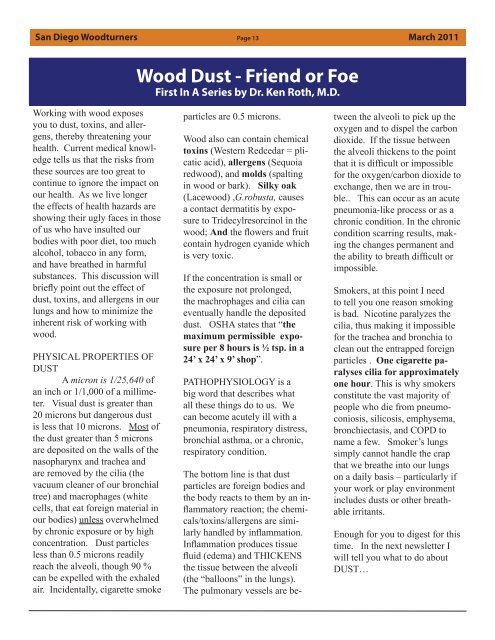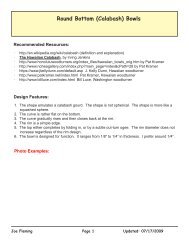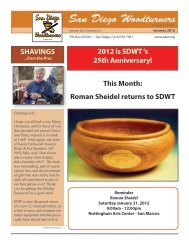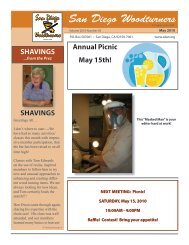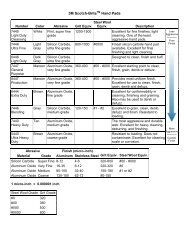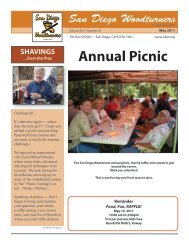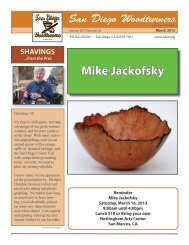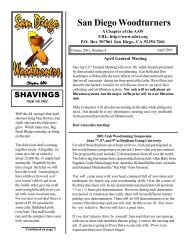March - San Diego Woodturners
March - San Diego Woodturners
March - San Diego Woodturners
You also want an ePaper? Increase the reach of your titles
YUMPU automatically turns print PDFs into web optimized ePapers that Google loves.
<strong>San</strong> <strong>Diego</strong> <strong>Woodturners</strong> Page 13 <strong>March</strong> 2011<br />
Wood Dust - Friend or Foe<br />
First In A Series by Dr. Ken Roth, M.D.<br />
Working with wood exposes<br />
you to dust, toxins, and allergens,<br />
thereby threatening your<br />
health. Current medical knowledge<br />
tells us that the risks from<br />
these sources are too great to<br />
continue to ignore the impact on<br />
our health. As we live longer<br />
the effects of health hazards are<br />
showing their ugly faces in those<br />
of us who have insulted our<br />
bodies with poor diet, too much<br />
alcohol, tobacco in any form,<br />
and have breathed in harmful<br />
substances. This discussion will<br />
briefly point out the effect of<br />
dust, toxins, and allergens in our<br />
lungs and how to minimize the<br />
inherent risk of working with<br />
wood.<br />
PHYSICAL PROPERTIES OF<br />
DUST<br />
A micron is 1/25,640 of<br />
an inch or 1/1,000 of a millimeter.<br />
Visual dust is greater than<br />
20 microns but dangerous dust<br />
is less that 10 microns. Most of<br />
the dust greater than 5 microns<br />
are deposited on the walls of the<br />
nasopharynx and trachea and<br />
are removed by the cilia (the<br />
vacuum cleaner of our bronchial<br />
tree) and macrophages (white<br />
cells, that eat foreign material in<br />
our bodies) unless overwhelmed<br />
by chronic exposure or by high<br />
concentration. Dust particles<br />
less than 0.5 microns readily<br />
reach the alveoli, though 90 %<br />
can be expelled with the exhaled<br />
air. Incidentally, cigarette smoke<br />
particles are 0.5 microns.<br />
Wood also can contain chemical<br />
toxins (Western Redcedar = plicatic<br />
acid), allergens (Sequoia<br />
redwood), and molds (spalting<br />
in wood or bark). Silky oak<br />
(Lacewood) ,G.robusta, causes<br />
a contact dermatitis by exposure<br />
to Tridecylresorcinol in the<br />
wood; And the flowers and fruit<br />
contain hydrogen cyanide which<br />
is very toxic.<br />
If the concentration is small or<br />
the exposure not prolonged,<br />
the machrophages and cilia can<br />
eventually handle the deposited<br />
dust. OSHA states that “the<br />
maximum permissible exposure<br />
per 8 hours is ½ tsp. in a<br />
24’ x 24’ x 9’ shop”.<br />
PATHOPHYSIOLOGY is a<br />
big word that describes what<br />
all these things do to us. We<br />
can become acutely ill with a<br />
pneumonia, respiratory distress,<br />
bronchial asthma, or a chronic,<br />
respiratory condition.<br />
The bottom line is that dust<br />
particles are foreign bodies and<br />
the body reacts to them by an inflammatory<br />
reaction; the chemicals/toxins/allergens<br />
are similarly<br />
handled by inflammation.<br />
Inflammation produces tissue<br />
fluid (edema) and THICKENS<br />
the tissue between the alveoli<br />
(the “balloons” in the lungs).<br />
The pulmonary vessels are between<br />
the alveoli to pick up the<br />
oxygen and to dispel the carbon<br />
dioxide. If the tissue between<br />
the alveoli thickens to the point<br />
that it is difficult or impossible<br />
for the oxygen/carbon dioxide to<br />
exchange, then we are in trouble..<br />
This can occur as an acute<br />
pneumonia-like process or as a<br />
chronic condition. In the chronic<br />
condition scarring results, making<br />
the changes permanent and<br />
the ability to breath difficult or<br />
impossible.<br />
Smokers, at this point I need<br />
to tell you one reason smoking<br />
is bad. Nicotine paralyzes the<br />
cilia, thus making it impossible<br />
for the trachea and bronchia to<br />
clean out the entrapped foreign<br />
particles . One cigarette paralyses<br />
cilia for approximately<br />
one hour. This is why smokers<br />
constitute the vast majority of<br />
people who die from pneumoconiosis,<br />
silicosis, emphysema,<br />
bronchiectasis, and COPD to<br />
name a few. Smoker’s lungs<br />
simply cannot handle the crap<br />
that we breathe into our lungs<br />
on a daily basis – particularly if<br />
your work or play environment<br />
includes dusts or other breathable<br />
irritants.<br />
Enough for you to digest for this<br />
time. In the next newsletter I<br />
will tell you what to do about<br />
DUST…


